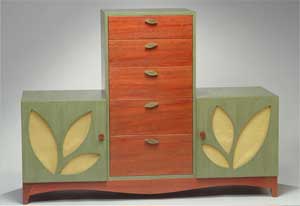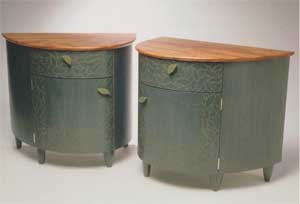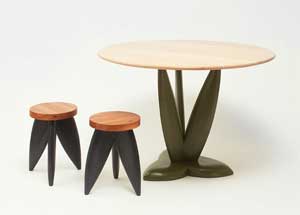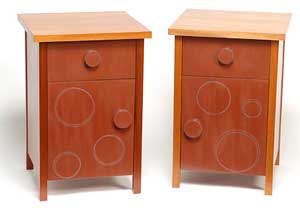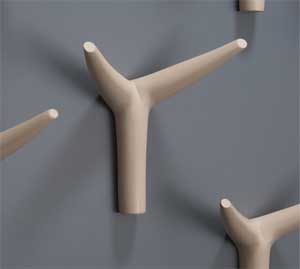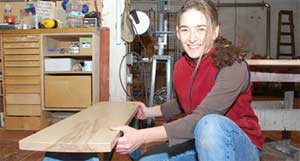
Rachel Fuld enjoys the process of shaping items, plus playing with the contrast of bare wood accents and surfaces finished with milk paint.
Being a woodworker, says Rachel Fuld, “seemed like a good choice when I was 21.”
She came to that conclusion after participating in an internship program with Philadelphia furniture maker Jack Larimore during her last semester at Oberlin College. “I had taken a few sculpture classes in college, and had built sets in high school. My sculpture teachers said, ‘You’re pretty good at this,’ so I thought, ‘Maybe I’ll try furniture,” Rachel said.
“It turned out to be a good experience. I wasn’t really interested in an office job. [Woodworking] related to doing something creative, but yet had a function. I liked being in a workshop, and I liked working with tools.”
Rachel will be a participating artist next week in the Philadelphia Museum of Art Contemporary Craft Show (Nov. 6-9), where the pieces in her booth will include things like a sideboard, bedside cabinet and tables.
“I’m interested in building work you can live with in the city, where city houses are generally smaller,” Rachel said. “I’m not really interested in large furniture.”
Lately, “I have been building a lot of cabinets,” she said. “I like drawers; I like figuring out how to make the best of space and also make it fun.”
Some of that fun comes from “playing with interior and exterior,” as in the case of her semicircular bedside tables, in which the cabinet tops are sapele, but the exterior and interior of the cabinets themselves are painted in different colors.
Admittedly, Rachel said, “People don’t always like a painted surface: they like wood, like sapele, or quilted mahogany, even though a painted surface takes as much or more time as natural wood.”
In her own work, “I’m trying to combine milk paint surface with bare wood accents,” Rachel said.
She has used milk paint, from The Old Fashioned Milk Paint Company, since she started out in furniture making, often mixing colors. “Sometimes I mix in with black or mix different colors. As you sand, the different layers show through,” Rachel said. “I sand between coats and then steel wool the final coat so it gets very shiny. I sand it down so it’s very smooth; it’s a very hard finish. I do oil it and put some kind of lacquer over the milk paint.”
Milk paint also adds a visual texture, Rachel said: “Because of the way it lays down as you brush it, has a texture; you can’t really feel it, but you can see it.” Plus, it adds visual interest in reaction to certain woods – which influences her wood choices.
“I like using mahogany; when you use it underneath milk paint, the milk paint interacts with the tannins in the mahogany,” she said. “If you sand through on a corner, a beautiful red comes through.”
“In addition to mahogany, I do love cherry, and how rich it gets,” Rachel said, noting that she has made benches from cherry. “Everybody loves walnut these days – walnut’s not my favorite.”
Overall, Rachel said, “My work is less about technique and more about form and shape: the combination of colors and lines.”
With her recent resurgence in studio time – “I worked very, very part-time for a number of years, because I was the main caretaker” for her two young children, now 11 and 6 – Rachel said, she’s interested in “bringing my work back to a bit more sculptural.”
“I really enjoy shaping things,” she said. One example is her Ossements (“bone” in French) hangers project (photo below), which she originally designed for an invitational show at the Center for Art in Wood on “Your Personal Hangups.” “Some people made very functional things; others made very personal things about their ‘hangups,’”Rachel said.
“I was inspired by a wire sculpture in the window of art gallery I walk by every day. It’s tripods with pieces on the ends.”
Translating that into her Ossements, “There’s three different pieces of wood, and everything’s angled, and you have to have a jig for the joinery, and then you have to hand shape them,” she said. “Some are smaller, some are a bit bigger, depending on which batch, but the angles are always the same, so you can use jigs.”
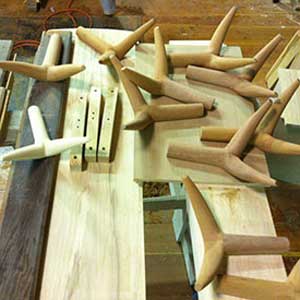
“They’re probably not worth the effort for what I’m selling them for, but I really like the shaping,” Rachel said.
Rachel also says she enjoys the community of woodworkers, whether that’s the other people in her five-person shop, or members of the Furniture Society. “Any time I need to be rejuvenated, to meet other people and see what other people are doing, that’s been really valuable to me,” she said of her membership in that organization.
Overall, as a woodworker, Rachel said, “I feel really lucky to be doing what I’m doing.”
